https://americanenglish.state.gov/files/ae/resource_files/the_story_of_william_wilson.pdf
Friday, December 22, 2017
Monday, April 3, 2017
Life of Pi
Here is the IMDB.COM page for the film:
http://www.imdb.com/title/tt0454876/
Interviews with the author of the novel:
http://www.theguardian.com/books/2002/nov/26/fiction
http://textualities.net/jennie-renton/yann-martel-interview/
Other articles about the novel/film:
http://www.sfgate.com/entertainment/article/French-director-swept-away-by-Life-of-Pi-2565015.php
http://www.theministryrookie.com/2013/02/25/does-the-life-of-pi-prove-the-existence-of-god/
http://www.theguardian.com/books/2002/may/25/fiction.reviews1
http://www.imdb.com/title/tt0454876/
Interviews with the author of the novel:
http://www.theguardian.com/books/2002/nov/26/fiction
http://textualities.net/jennie-renton/yann-martel-interview/
Other articles about the novel/film:
http://www.sfgate.com/entertainment/article/French-director-swept-away-by-Life-of-Pi-2565015.php
http://www.theministryrookie.com/2013/02/25/does-the-life-of-pi-prove-the-existence-of-god/
http://www.theguardian.com/books/2002/may/25/fiction.reviews1
Monday, March 20, 2017
in Class
“A
Good Man is Hard to Find”
1)
O’Connor argued that not only is The
Misfit more intelligent than the grandmother but his “capacity for grace” is
greater than hers. Do you agree with this? Why or why not? Provide proof of
your belief.
2)
Some readers have found the
grandmother sympathetic and others have found her a figure of evil, portrayed
with imagery often associated with witches. What do you think of her?
3)
Between The Misfit and the grandmother, who seems to have a more solid
foundation in faith?
Definitions
of grace: a state of sanctification by God; the
state of one who is under such divine influence, elegance and beauty of
movement or expression
Quotes from the author:
“All my
stories are about the action of grace on a character who is not very willing to
support it, but most people think of these stories as hard, hopeless and
brutal.”
“Faith is what someone knows to be true, whether
they believe it or not.”
“I preach there are all kinds of truth, your
truth and somebody else's. But behind all of them there is only one truth and
that is that there's no truth.”
“The truth does not change according to our
ability to stomach it.”
“While much attention has been paid to the scene between the
Grandmother and the Misfit at the climax of “A Good Man Is Hard to Find,” only
passing attention has been paid to a scene early in the story where the
Grandmother makes comments from the car about “the cute little pickaninny,” and
no explication to date has revealed the Christian mystery behind the Southern manners
in the scene. In this crucial passage, through the use of biblical allusion,
O'Connor allows the Grandmother the chance to reveal her essential self and
prepares the reader for the climax of the story” (Walls).
Southern Culture
The road as a metaphor for life:
Religious Signs in the South:
"A Good Man is Hard to Find"
Links on Southern Culture:
More on "A Good Man is Hard to Find":
http://web.a.ebscohost.com/ehost/pdfviewer/pdfviewer?vid=9&sid=7a0d2f82-11ba-4046-80b7-8b3557846338%40sessionmgr4002&hid=4214
http://commons.pacificu.edu/cgi/viewcontent.cgi?article=1038&context=casfac
http://dsq-sds.org/article/view/607/784
O'Connor reading the story and commentary:
http://www.openculture.com/2012/05/rare_1959_audio_flannery_oconnor_reads_a_good_man_is_hard_to_find.html
http://www.theguardian.com/books/booksblog/2011/jul/05/fresh-look-flannery-o-connor-cartoons
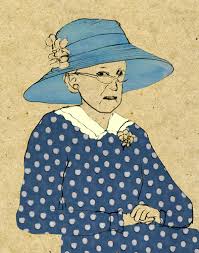
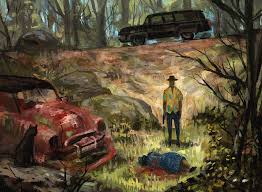
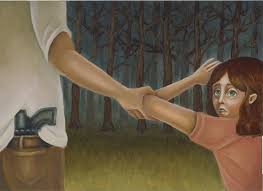
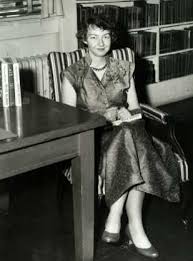
Folow this link for a collection of links about the story:
More on "A Good Man is Hard to Find":
http://web.a.ebscohost.com/ehost/pdfviewer/pdfviewer?vid=9&sid=7a0d2f82-11ba-4046-80b7-8b3557846338%40sessionmgr4002&hid=4214
http://commons.pacificu.edu/cgi/viewcontent.cgi?article=1038&context=casfac
http://dsq-sds.org/article/view/607/784
O'Connor reading the story and commentary:
http://www.openculture.com/2012/05/rare_1959_audio_flannery_oconnor_reads_a_good_man_is_hard_to_find.html
http://www.theguardian.com/books/booksblog/2011/jul/05/fresh-look-flannery-o-connor-cartoons
Four collections of essays provide a good range of criticism on O’Connor (These would be found in the Literary Criticism section of a book store or library):
1. The Added Dimension: The Art and Mind of Flannery O’Connor, edited by Melvin J. Friedman and Lewis A. Lawson (1966; rpt. Fordham University Press, 1977).
2. Critical Essays on Flannery O’Connor, edited by Melvin J. Friedman and Beverly Lyon Clark (Hall, 1985).
3. Flannery O’Connor, edited by Harold Bloom (Chelsea House, 1986).
4. Realist of Distances: Flannery O’Connor Revisited, edited by Karl-Heinz Westarp and Jan Nordby Gretlund (Aarhus, 1987).
The Misfit with the grandmother:
Taking the family to the woods:
The author:
Wednesday, March 15, 2017
"A Very Old Man With Enormous Wings"
This is an article about villagers mistaking a sex doll for an angel:
http://www.nydailynews.com/news/world/sex-toy-washes-indonesian-beach-locals-angel-article-1.2624725
Magical Realism:
http://www.princeton.edu/~achaney/tmve/wiki100k/docs/Magic_realism.html
http://www.english.iup.edu/pagnucci/courses/121/definitions/litdefinition-magicalrealism.htm
This article discusses "A Very Old Man With Enormous Wings" and magical realism:http://mockingbird.creighton.edu/NCW/marquez.htm
Here is a list of fairytales that you may want to reference:http://ivyjoy.com/fables/
http://www.cs.cmu.edu/~spok/grimmtmp/
What makes a story a fairy tale?http://www.voxmagazine.com/blog/2012/10/what-makes-a-fairy-tale/
http://books.google.com/books?hl=en&lr=&id=jkSzkr4UWDgC&oi=fnd&pg=PP1&dq=what+makes+a+story+a+fairy+tale&ots=5INIgjj9fI&sig=-bBpPAXuosHCiUyBu3uFbQmYHOA#v=onepage&q=what%20makes%20a%20story%20a%20fairy%20tale&f=false
http://books.google.com/books?hl=en&lr=&id=-AR9FEgly9wC&oi=fnd&pg=PA64&dq=what+makes+a+story+a+fairy+tale&ots=AcMzBieWQS&sig=UY-nsUqv1cfOsWdlWoEEM7Nr7A8#v=onepage&q=what%20makes%20a%20story%20a%20fairy%20tale&f=false
http://books.google.com/books?hl=en&lr=&id=1esOc6GGtOsC&oi=fnd&pg=PA2&dq=what+makes+a+story+a+fairy+tale&ots=0d0nbXFdyu&sig=XK7cnjf_z8L06Q5aEzwxBNZbBss#v=onepage&q=what%20makes%20a%20story%20a%20fairy%20tale&f=false
"A Very Old Man With Enormous Wings"
http://www.academia.edu/1000317/Marquezs_A_Very_Old_Man_with_Enormous_Wings_and_Bambaras_The_Lesson
http://litmed.med.nyu.edu/Annotation?action=view&annid=12287
Author's Obit:http://www.nytimes.com/2014/04/18/books/gabriel-garcia-marquez-literary-pioneer-dies-at-87.html?_r=0

http://www.nydailynews.com/news/world/sex-toy-washes-indonesian-beach-locals-angel-article-1.2624725
Magical Realism:
http://www.princeton.edu/~achaney/tmve/wiki100k/docs/Magic_realism.html
http://www.english.iup.edu/pagnucci/courses/121/definitions/litdefinition-magicalrealism.htm
This article discusses "A Very Old Man With Enormous Wings" and magical realism:http://mockingbird.creighton.edu/NCW/marquez.htm
Here is a list of fairytales that you may want to reference:http://ivyjoy.com/fables/
http://www.cs.cmu.edu/~spok/grimmtmp/
What makes a story a fairy tale?http://www.voxmagazine.com/blog/2012/10/what-makes-a-fairy-tale/
http://books.google.com/books?hl=en&lr=&id=jkSzkr4UWDgC&oi=fnd&pg=PP1&dq=what+makes+a+story+a+fairy+tale&ots=5INIgjj9fI&sig=-bBpPAXuosHCiUyBu3uFbQmYHOA#v=onepage&q=what%20makes%20a%20story%20a%20fairy%20tale&f=false
http://books.google.com/books?hl=en&lr=&id=-AR9FEgly9wC&oi=fnd&pg=PA64&dq=what+makes+a+story+a+fairy+tale&ots=AcMzBieWQS&sig=UY-nsUqv1cfOsWdlWoEEM7Nr7A8#v=onepage&q=what%20makes%20a%20story%20a%20fairy%20tale&f=false
http://books.google.com/books?hl=en&lr=&id=1esOc6GGtOsC&oi=fnd&pg=PA2&dq=what+makes+a+story+a+fairy+tale&ots=0d0nbXFdyu&sig=XK7cnjf_z8L06Q5aEzwxBNZbBss#v=onepage&q=what%20makes%20a%20story%20a%20fairy%20tale&f=false
"A Very Old Man With Enormous Wings"
http://www.academia.edu/1000317/Marquezs_A_Very_Old_Man_with_Enormous_Wings_and_Bambaras_The_Lesson
http://litmed.med.nyu.edu/Annotation?action=view&annid=12287
Author's Obit:http://www.nytimes.com/2014/04/18/books/gabriel-garcia-marquez-literary-pioneer-dies-at-87.html?_r=0
Tuesday, February 21, 2017
"The Temp" and "The Handsomest Drowned Man in the World"
"The Temp" and "The Handsomest Drowned Man in the World"
The Importance of
appearance:
http://elitedaily.com/news/world/the-importance-of-appearances-man-dresses-as-homeless-man-to-prove-nobody-would-help-him-video/592301/
http://www.ridingthetiger.org/2013/03/19/the-importance-of-appearance/
http://www.byui.edu/Documents/Admin_Offices/Advising/PowerOfPersonalAppearance.pdf
http://www.nytimes.com/2012/04/22/opinion/sunday/a-facial-theory-of-politics.html?module=Search&mabReward=relbias%3Aw
http://cityroom.blogs.nytimes.com/2010/06/08/appearances-mean-nothing-or-everything/?module=Search&mabReward=relbias%3Aw
http://www.nytimes.com/2009/04/26/fashion/26looks.html?pagewanted=all&module=Search&mabReward=relbias%3Aw
Office Culture:
http://www.nytimes.com/2014/06/01/opinion/sunday/why-you-hate-work.html?smid=fb-nytimes&WT.z_sma=OP_WYH_20140602&bicmp=AD&bicmlukp=WT.mc_id&bicmst=1388552400000&bicmet=1420088400000&_r=3
http://www.forbes.com/sites/vickvaishnavi/2013/03/28/five-must-follow-rules-for-a-successful-office-culture/
http://www.huffingtonpost.com/tag/office-culture/
http://www.immihelp.com/newcomer/work-culture-office-environment-usa.html
https://www.themuse.com/advice/rally-the-team-how-to-create-a-cool-office-culture
Culture:
http://elitedaily.com/news/world/the-importance-of-appearances-man-dresses-as-homeless-man-to-prove-nobody-would-help-him-video/592301/
http://www.ridingthetiger.org/2013/03/19/the-importance-of-appearance/
http://www.byui.edu/Documents/Admin_Offices/Advising/PowerOfPersonalAppearance.pdf
http://www.nytimes.com/2012/04/22/opinion/sunday/a-facial-theory-of-politics.html?module=Search&mabReward=relbias%3Aw
http://cityroom.blogs.nytimes.com/2010/06/08/appearances-mean-nothing-or-everything/?module=Search&mabReward=relbias%3Aw
http://www.nytimes.com/2009/04/26/fashion/26looks.html?pagewanted=all&module=Search&mabReward=relbias%3Aw
Office Culture:
http://www.nytimes.com/2014/06/01/opinion/sunday/why-you-hate-work.html?smid=fb-nytimes&WT.z_sma=OP_WYH_20140602&bicmp=AD&bicmlukp=WT.mc_id&bicmst=1388552400000&bicmet=1420088400000&_r=3
http://www.forbes.com/sites/vickvaishnavi/2013/03/28/five-must-follow-rules-for-a-successful-office-culture/
http://www.huffingtonpost.com/tag/office-culture/
http://www.immihelp.com/newcomer/work-culture-office-environment-usa.html
https://www.themuse.com/advice/rally-the-team-how-to-create-a-cool-office-culture
Culture:
These links discuss cultural differences and also provides
a number of links if you go to the bottom of the page. Use the information they
provide as outside sources if you are writing your essay about this
subject:http://blue.butler.edu/~jfmcgrat/culture.htm
http://www.worldwide.edu/travel_planner/culture_shock.html
http://www.ccsenet.org/journal/index.php/ijps/article/view/4510
Here is one on the effects of culture shock:http://scholar.google.com/scholar?q=effects+culture+shock&hl=en&as_sdt=0&as_vis=1&oi=scholart&sa=X&ei=tIk6T-mJBaLn0QHXj5GXCw&ved=0CBoQgQMwAA
Links for "The Handsomest Drowned Man In the World":
http://www.worldwide.edu/travel_planner/culture_shock.html
http://www.ccsenet.org/journal/index.php/ijps/article/view/4510
Here is one on the effects of culture shock:http://scholar.google.com/scholar?q=effects+culture+shock&hl=en&as_sdt=0&as_vis=1&oi=scholart&sa=X&ei=tIk6T-mJBaLn0QHXj5GXCw&ved=0CBoQgQMwAA
Links for "The Handsomest Drowned Man In the World":
This week we will look at “The Handsomest Drowned Man in
the World”, “The Temp” and Edward Scissorhands in class. All three of
these stories contain individuals that become part of a community in some way
and have profound effects of the people. In “The Handsomest Drowned Man in the
World” it is a corpse that washes ashore that gives the townspeople a new way of
looking at their lives, in “The Temp” it is a temp hired in an office that
changes the atmosphere of the wor enviroment and in Edward
Scissorhands it is a unique young man that forces a rather boring town to
see how boring and judgmental they really are. This week pay attention to what
these “magical strangers” force the people in the stories to look at it in their
lives.
Wednesday, February 8, 2017
Class Announcement
For the Tuesday 10am class...
Our next meeting is Tuesday Feb 21 so NO CLASS NEXT WEEK (Feb 14).
For the Mon/Wed 1pm class...
Our next meeting is Wed Feb 22 so NO CLASS NEXT WEEK (Feb 13 and 15).
Both classes will be watching The Village when we return.
Our next meeting is Tuesday Feb 21 so NO CLASS NEXT WEEK (Feb 14).
For the Mon/Wed 1pm class...
Our next meeting is Wed Feb 22 so NO CLASS NEXT WEEK (Feb 13 and 15).
Both classes will be watching The Village when we return.
Monday, February 6, 2017
"The Sisterhood of the Night" and "The Lottery"
The Sisterhood of the Night
The richest of the stories in this vein is ''The Sisterhood of Night,'' in which Millhauser adopts one of his familiar narrative voices -- the affable small-town archivist explaining some local peculiarity to an inquisitive stranger.

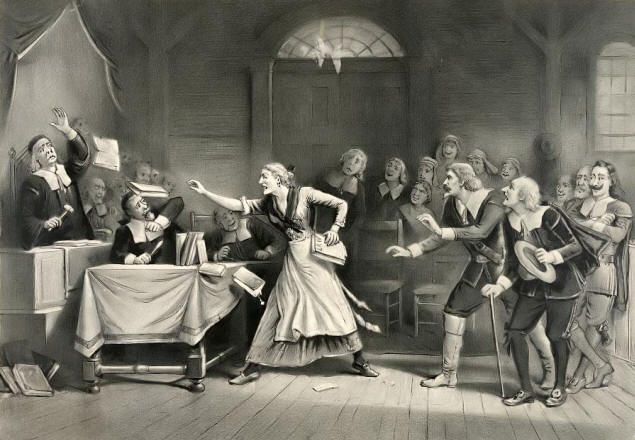
It seems that adolescent girls are going out at night in bands, seeking ''dark and secret places.'' Witchcraft is suspected, and also various unspeakable sexual perversions. ''What shall we do with our daughters?'' is the refrain of the adults. ''Tell us! we cry, our voices shrill with love. Tell us everything! Then we will forgive you.'' When the secret is revealed, we at first suspect that a joke is being made about teen-age girls and their ways. On reflection, we discover more complex meanings, to do with privacy, sanctuary and the unknowability of other minds. It is a lovely, haunting story, whose apparent simplicity masks its true depth.

Salem Witch Trials/Hunt:

The Lottery
Articles on tradition:
This article discusses how different cultures address death:
http://articles.latimes.com/2012/aug/19/local/la-me-0819-lopez-dyingwell-20120819
This link discusses American Culture:
http://www.americanfamilytraditions.com/american_culture.htm
Here is a link to what The Bible has to say about culture:
http://www.openbible.info/topics/traditions
This is an interesting look at how different cultures have different traditions when it comes to childcare:
http://alphamom.com/parenting/interesting-parenting-traditions-from-different-cultures/


 Somebody made a short movie based on the story:
Somebody made a short movie based on the story:
http://www.youtube.com/watch?v=RV03h3XWTDU
Criticism:
http://home.netwood.net/kosenko/jackson.html
http://www.literaryhistory.com/20thC/Jackson.htm
GROUPTHINK:
http://www.psysr.org/about/pubs_resources/groupthink%20overview.htm
http://www.abacon.com/commstudies/groups/groupthink.html
http://oregonstate.edu/instruct/theory/grpthink.html
http://boingboing.net/2014/08/05/how-groupthink-gets-reality-ba.html?utm_content=buffer54149&utm_medium=social&utm_source=facebook.com&utm_campaign=buffer
This article discusses how different cultures address death:
http://articles.latimes.com/2012/aug/19/local/la-me-0819-lopez-dyingwell-20120819
This link discusses American Culture:
http://www.americanfamilytraditions.com/american_culture.htm
Here is a link to what The Bible has to say about culture:
http://www.openbible.info/topics/traditions
This is an interesting look at how different cultures have different traditions when it comes to childcare:
http://alphamom.com/parenting/interesting-parenting-traditions-from-different-cultures/

 Somebody made a short movie based on the story:
Somebody made a short movie based on the story:http://www.youtube.com/watch?v=RV03h3XWTDU
Criticism:
http://home.netwood.net/kosenko/jackson.html
http://www.literaryhistory.com/20thC/Jackson.htm
GROUPTHINK:
http://www.psysr.org/about/pubs_resources/groupthink%20overview.htm
http://www.abacon.com/commstudies/groups/groupthink.html
http://oregonstate.edu/instruct/theory/grpthink.html
http://boingboing.net/2014/08/05/how-groupthink-gets-reality-ba.html?utm_content=buffer54149&utm_medium=social&utm_source=facebook.com&utm_campaign=buffer
Wednesday, January 25, 2017
In Class Assimilation Discussion
“Two
Kinds” and “Brave We Are”
The
main issue we will see in these two stories and the film The Namesake next week is what issues people face when they leave
their country of origin and come to America for a better life.
1)
Do you think the cultural issues that come up
in these two stories are unique to particular cultures or not? Explain.
2)
The
mother in “Two Kinds” believes there are two kinds of daughters. How does she
define the two kinds of daughters and do you think her daughter agrees with her
by the end of the story?
3)
In ‘Brave We Are” while giving her
explanation to her son, what is the narrator’s conflict? What is she concerned
about? Should she be? Would you be in this circumstance?
4)
To
what extent is the meal the narrator is preparing a metaphor for what she is
explaining? What does she mean in the last line of the story, “The strand must
remain smooth, elusive and separate”?
5)
What
pressures arise from assimilation? How do families address these issues?
6)
How
symbols were used in “Brave We Are” to explain some of the issues new Americans
face?
a) the meal
b) the song
c) the poem
7)
In
“Two Kinds” the mother puts a lot of pressure of her daughter to do well. This
can be referred to as her “putting all her eggs in one basket”. Explain how she
attempts to shape her daughter’s life in the story
Below
is a quote from President Obama’s speech in 2012 about America. Keep it in mind
for these two stories and the film we will watch this week.
“…The basic American promise that if you worked hard, you could do well
enough to raise a family, own a home, send your kids to college, and put a
little away for retirement. The defining issue of our time is how to keep that
promise alive.”
From
a Washington Post Article on our class blog:
"It's difficult to adapt to the culture here,"
said Maria Jacinto, 32, who moved to the United States 10 years ago with her
husband, Aristeo Jacinto, 36. "In the Hispanic tradition, the family comes
first, not money. It's important for our children not to be influenced too much
by the gueros," she said, using a term that means
"blondies" but that she employs generally in reference to Americans.
"I don't want my children to be influenced by immoral things."
The Namesake
“Alone together in a foreign land in the middle of winter, the
shy, polite newlyweds are virtual strangers, and the movie captures their
delicate process of mutual accommodation. Ashima’s initiation into American
culture has gentle, humorous moments. She is astonished to discover gas stoves
that work 24 hours a day and learns the hard way that wool sweaters should not
be dumped into a washing machine” (Holden).
“In high school Gogol rebels from his family and behaves like a
typical pot-smoking, rock-’n’-roll-loving American teenager. On a visit to
Calcutta he sneers at Indian ways. After studying architecture at Yale, he
falls in love with Maxine (Jacinda Barrett), a stereotypical blonde WASP
princess from Long Island. Cultural tensions flare when he brings her home to
meet his family, and the couple are expected to withhold any expressions of
physical affection, according to Indian tradition” (Holden).
Monday, January 23, 2017
Assimilation, The Namesake, "Brave We Are" and "Two Kinds"
http://mobile.nytimes.com/2015/11/01/education/edlife/international-students-find-the-american-dream-in-flint.html?smid=fb-nytimes&smtyp=cur&referer=http://m.facebook.com&_r=0
Article about choosing names for children born in America to new Americans:
http://mobile.nytimes.com/2015/10/04/opinion/sunday/for-muslim-americans-baby-aidan-or-baby-muhammad.html?smid=fb-nytimes&smtyp=cur&referer=http://m.facebook.com&_r=0
http://mobile.nytimes.com/2015/10/04/opinion/sunday/for-muslim-americans-baby-aidan-or-baby-muhammad.html?smid=fb-nytimes&smtyp=cur&referer=http://m.facebook.com&_r=0
http://douthat.blogs.nytimes.com/2013/06/12/the-great-assimilation-debate/
http://www.nytimes.com/2013/04/28/opinion/sunday/douthat-when-the-assimilation-of-immigrants-stalls.html
http://www.nytimes.com/1994/04/07/garden/l-benefits-of-assimilation-229202.html
http://www.nytimes.com/2009/03/15/us/15immig.html?pagewanted=all
http://learning.blogs.nytimes.com/2009/12/08/right-there-in-black-and-white-identity-assimilation-and-the-resume/?_r=0
These links would help with the issues in "Two Kinds" also:
Here is a link that talks about assimilation into American/other cultures.
http://www.nydailynews.com/life-style/children-tiger-moms-european-american-moms-differ-article-1.1798300
Here is a link that talks about assimilation into American/other cultures.
http://www.nydailynews.com/life-style/children-tiger-moms-european-american-moms-differ-article-1.1798300
http://www.asian-nation.org/assimilation.shtml
http://www.jstor.org/discover/10.2307/2673184?uid=3739808&uid=2&uid=4&uid=3739256&sid=21104040633247
http://psycnet.apa.org/journals/edu/89/3/433/
http://jbd.sagepub.com/content/29/6/505.short
Interview with Amy Tan (author of "Two Kinds")
http://www.jstor.org/discover/10.2307/2673184?uid=3739808&uid=2&uid=4&uid=3739256&sid=21104040633247
http://psycnet.apa.org/journals/edu/89/3/433/
http://jbd.sagepub.com/content/29/6/505.short
Interview with Amy Tan (author of "Two Kinds")
Here is a link to the PBS website that discusses “New Americans”:
Here is a link that is specific to people living in new
Here is an article entitled: “Why They Won’t Assimilate”:
http://www.americanthinker.com/2007/05/why_they_wont_assimilate.html
http://www.americanthinker.com/2007/05/why_they_wont_assimilate.html
.
President Obama’s speech about in which he discusses the American dream and what it means to us today.
http://www.psy.miami.edu/faculty/dmessinger/c_c/rsrcs/rdgs/peers_social_general/Varela_etal_2004.pdf
The psychological definition:
https://www.vice.com/en_us/article/when-i-immigrated-tv-taught-me-how-to-be-an-american
More on Assimilation:
Tuesday, January 17, 2017
"Mrs. Turner's Lawn Jockeys"
We will discuss identity and how we become who we are in "Mrs. Turner's Lawn Jockeys"and Stand By Me. We will see different characters and explore how they constructed their identity. Setting also plays a major role in these stories. We will look at how that effects these characters as well.
http://www.psychologytoday.com/basics/identity
Identity and choice:
http://gawker.com/how-i-identify-is-not-your-choice-1741671073
Link about identity and where you are from:
http://www.citylab.com/navigator/2015/10/what-youre-really-asking-when-you-ask-where-are-you-from/411688/
This link below has a wide variety of articles on how we construct identity.
http://www.psychologytoday.com/basics/identity
Identity and choice:
http://gawker.com/how-i-identify-is-not-your-choice-1741671073
History of Lawn Jockeys
Black face
Link about identity and where you are from:
http://www.citylab.com/navigator/2015/10/what-youre-really-asking-when-you-ask-where-are-you-from/411688/
Wednesday, January 11, 2017
Monday, January 9, 2017
Syllabus
Prof. Sean
O’Connell Mon
Wed1-2:20
Email:soconnel@essex.edu
Phone: 973-877-1926 Office:
1141
Office Hours: M/T/W Room:
9:00-10:00
Texts: Literature: A Portable Anthology 4TH
EDITION
ISBN-13:
978-1319075439
January
Eng 102
9 Introduction, go over syllabus,
Handout, GET TEXT!
11 “Sonny’s Blues” (223)
18 “Mrs Turner’s Lawn Jockeys”
(Packet)
23 ‘Two Kinds” (Handout)
25 “Brave We Are” (Packet)
30 Film: The Namesake
February
1 Film: The Namesake, ASSIGN PAPER#1
6 FIRST ESSAY DUE, “The
Lottery” (216)
8
“The Sisterhood of the Night” (Packet)
13 NO CLASS
15 NO CLASS
20 NO CLASS
22 Film: The Village
27 Film:
The Village
March
1 “The Temp” (Handout)
6
“The Handsomest Drowned Man in the
World” (Packet)
8 Film: Edward Scissorhands, ASSIGN PAPER#2
13 Film: Edward Scissorhands
15“The Old Man With Enormous Wings” (263)
20 SECOND ESSAY DUE “A
Good Man Is Hard to Find” (250)
22 NO CLASS—HUMANITIES CONFERENCE—EXTRA CREDIT
CHANCE
27 Film: Life of Pi
29 Film: Life of Pi
April
3 “The Things They Carried” (322)
5 ASSIGN FINAL PAPER
10 BRING IN DRAFTS FOR REVIEW
1141
12 FINAL PAPER DUE
"Sonny's Blues"
Outside sources for Baldwin:
http://www.csustan.edu/english/reuben/pal/chap10/baldwin.html
 http://www.nytimes.com/books/98/03/29/specials/baldwin.html?scp=3&sq=james%20baldwin&st=cse
http://www.nytimes.com/books/98/03/29/specials/baldwin.html?scp=3&sq=james%20baldwin&st=cse
Baldwin sources:
http://www.literaryhistory.com/20thC/Baldwin.htm
 History of Harlemhttp://www.harlemheritage.com/history-of-harlem/
History of Harlemhttp://www.harlemheritage.com/history-of-harlem/
http://www.biography.com/tv/classroom/harlem-renaissance
http://www.history.com/topics/harlem-renaissance
 Below is the Bible scripture that Baldwin refers to:
Below is the Bible scripture that Baldwin refers to:
“The cup of trembling”
22
Thus saith thy Lord the LORD, and thy God that pleadeth the cause of his people, Behold, I have taken out of thine hand the cup of trembling, even the dregs of the cup of my fury; thou shalt no more drink it again:
23
But I will put it into the hand of them that afflict thee; which have said to thy soul, Bow down, that we may go over: and thou hast laid thy body as the ground, and as the street, to them that went over
http://www.csustan.edu/english/reuben/pal/chap10/baldwin.html
Baldwin sources:
http://www.literaryhistory.com/20thC/Baldwin.htm
http://www.biography.com/tv/classroom/harlem-renaissance
http://www.history.com/topics/harlem-renaissance
“The cup of trembling”
22
Thus saith thy Lord the LORD, and thy God that pleadeth the cause of his people, Behold, I have taken out of thine hand the cup of trembling, even the dregs of the cup of my fury; thou shalt no more drink it again:
23
But I will put it into the hand of them that afflict thee; which have said to thy soul, Bow down, that we may go over: and thou hast laid thy body as the ground, and as the street, to them that went over
1) At one point the narrator says that Sonny was playing “playing for his life”; what does this quotation mean to you? Explain
2) Can you find a place in the story where Baldwin makes use of the images of darkness and light? Explain the use of light and darkness
3) Reread the exchange between the narrator and Sonny's friend. How would you characterize the narrator's behavior and feelings towards Sonny's friend ? Is the narrator kind, cruel, compassionate, abrupt, empathic, angry? Explain your view and the evidence supporting it. Why does the narrator react the way he does?
4) Critics have said that “Sonny’s Blues” is a story about hope but that hope is tempered by knowledge of terrible dangers. Explain what you think that means.
Subscribe to:
Posts (Atom)